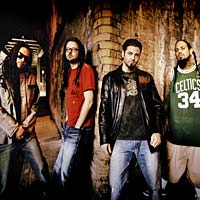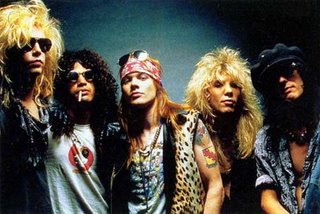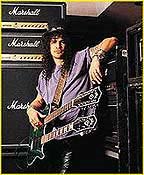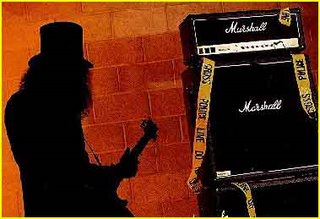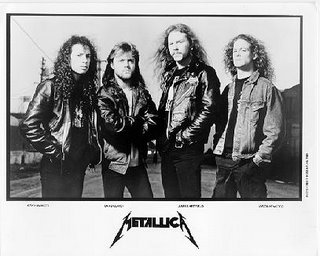
Downey, California, in 1981 by Lars Ulrich and James Hetfield after they each placed classified advertisements in the publication The Recycler. Hetfield, who had been influenced by the New Wave of British Heavy Metal, tried to start his own band before contacting Ulrich but was unsuccessful. Bassist Ron McGovney was an original member, and the band used a few transient guitar players, such as Brad Parker and Jeff Warner. At their first session, in Lars Ulrich's garage, there were only three members, Ulrich, Hetfield, and Lloyd Grant, but McGovney joined a few days later.
Metallica got its name when San Francisco-area metal promoter Ron Quintana asked Ulrich to help pick out a name for his new magazine to promote U.S. and British metal bands. Quintana came up with a list that included "Metallica," but Lars suggested "Metal Mania" and used "Metallica" for the band he and Hetfield had just started.
In early 1982, Metallica recorded "Hit the Lights" for the first Metal Massacre compilation. Desperate for a full time lead guitarist, Ulrich posted an advert in a local newspaper. Dave Mustaine from Huntington Beach, California, from the band Panic responded and met for an audition. Ulrich and Hetfield were so impressed with Mustaine's warm-up and equipment, they asked him to join before the audition began.
A few months later the band recorded a full demo, No Life 'Til Leather, which quickly drew attention on the underground tape trading circuit. After conflicts with Mustaine, McGovney left the band and was replaced by Cliff Burton from Castro Valley, California. Burton was lured from his band Trauma with the proviso Metallica relocated to the San Francisco area.
When the group arrived in El Cerrito, California, live performances and word-of-mouth enabled it to quickly build a healthy following in the Bay Area thrash metal scene. The music was inspired by bands such as Motörhead and Diamond Head (as the band declared in the sleeve notes of Garage Inc. (1998) "two heads were better than one"), Saxon and other British metal bands. They also took inspiration from hardcore punk bands like the Misfits and Discharge.
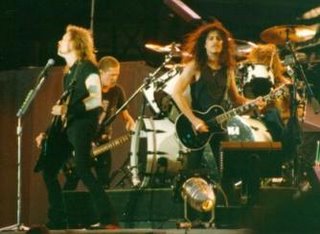
Metallica then travelled to Rochester, New York, in 1983 at the urging of local promoters Jon and Marsha Zazula, and after a few gigs the band signed with the Zazulas' new label, Megaforce Records. Shortly after arriving in New York, Ulrich and Hetfield decided Mustaine's aggressive and disruptive behavior relating to his extensive alcohol and drug problems was becoming too much to handle. Mustaine was asked to leave the band, and Kirk Hammett was drafted from Exodus to replace him. A former pupil of Joe Satriani, Hammett brought to the band his own unique style. This would become more apparent after Ride the Lightning, the first album to feature Hammett's songwriting. Mustaine would go on to create the hugely-successful Megadeth.
Metallica released its first album, Kill 'Em All (1983) on Megaforce. The album set the template that they would follow throughout the 1980s, featuring Hetfield's heavy vocals and aggressive rhythm guitar. The album did not have huge initial sales, but consolidated their loyal fan base in the growing underground metal scene. A year later, Metallica released their Ride the Lightning (1984), adding complexity and further melodic flair to the thrash metal of their debut. Longer songs showcased lyrical and musical growth, like "Fade to Black", a slower, more introspective song that some thought reflected the thoughts of someone contemplating suicide. The song in fact was written after the band's equipment was stolen (most notably a Marshall amplifier, leading Hetfield to search multiple continents to find one with the same sound). The inclusion of slower, introspective songs with clean or acoustic guitar distinguished Metallica from most other thrash or heavy metal bands. Some tracks on Ride The Lightning contain riffs brought by Kirk Hammett from Exodus. "Trapped Under Ice", for example, is reminiscent of Exodus' "Impaler".
Latest NEWS Latest about Cliff Burton
Latest about Cliff BurtonJames Hetfield spoke to the Swedish newspaper Dagens Nyheter about the "memorial day" that was held Sept. 30, 2006 for late bassist Cliff Burton at the at Gyllene Rasten restaurant/bar in Ljungby, Dörarp, Sweden. It was on September 27, 1986 — 20 years ago — that Burton died in a tragic bus accident in Sweden, just over the road from where Gyllene Rasten is located.
On performing "Orion" live this past summer:
Hetfield: "That was the highlight of the set for me. It sums up Cliff and I cried every time I played it, but it was good tears. I was overwhelmed with gratitude for the fact that I had the opportunity to play in the same band as Cliff and learn things from him."
On the importance of Cliff, the musical genius:
Hetfield: "We never would have written guitar harmonies or instrumentals or songs with very intricate melodies and orchestrations without Cliff. We wouldn't be where we are today."

Clifford Lee Burton (February 10, 1962 – September 27, 1986) was the second bassist in the band Metallica, joining the band in late 1982 (replacing Ron McGovney.) His life and tragic death have inspired many songs from bands including Megadeth and Primus, as well as bassists such as Billy Sheehan, Les Claypool and John Myung. He was killed in a bus accident in Sweden, 1986.

